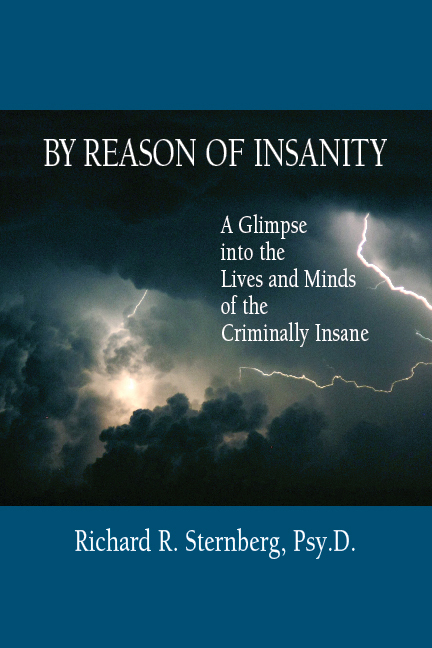By Reason of Insanity by Richard R. Sternberg
$35.00
ISBN: 978-1-949093-59-9
Click Here to Buy the Kindle eBook
Just in! The Kirkus Review of By Reason of Insanity by Richard R, Sternberg, PsyD:
In this book, a clinical psychologist uses examples from case histories to unravel the mysteries and dramas of patients whose crimes have resulted in their incarceration in a psychiatric hospital.
. . . Changing the names and recognizable details, the author uses the case histories of four long-term patients to explore the basic questions at the foundation of the text: “Who are these people? What are they like? How did they come to be that way? What have they done? And why?” The resulting narrative is an intriguing and informative examination of not only the lives and progressive disintegration of those deemed criminally insane, but also the legal system that led to their incarceration and the ironies and absurdities that permeated their treatments. Sternberg’s writing is lucid and his stories absorbing. . . .
An illuminating look at the dangerously unstable and the systems that control them.
From the introduction to By Reason of Insanity:
BY REASON OF INSANITY
Manolo Gonzalez, Donald Lane, David Reardon and Ronald Walensky all have two things in common: all were acquitted of serious criminal charges, and all have been incarcerated for many years – or decades. These seemingly contradictory statements are reconciled by the fact that all were found not guilty by reason of insanity or – as the statute actually reads – not responsible by reason of mental disease or defect. They have been confined not in prisons, but in the Kirby Forensic Psychiatric Center, a maximum-security forensic psychiatric hospital on Ward’s Island in New York City. In the past, such facilities were known as hospitals for the criminally insane.
People hold several erroneous ideas about the insanity plea. Many believe that this defense is very common, that it is often successful, and that those so acquitted “get away with” their crimes – that a successful insanity defense amounts to a free pass, a “get out of jail free” card. People hold these ideas, but the ideas hold little reality. The defense is, in fact, employed in less than one percent of criminal cases and is successful in far less than half the attempts. And, a successful insanity plea certainly does not mean avoidance of consequences for the crime. Very much the contrary. It is true that people who are acquitted on these grounds generally do not spend time in prison. However, they are incarcerated in secure psychiatric facilities, institutions that have more than a little in common with prisons. And they often spend far more time in these uninviting confines than they would have in prison, had they been convicted.
Furthermore, regardless of whether they ultimately spend more time in such a prison-hospital than they would have in prison, there is a particular kind of hell that attaches to their incarceration that does not pertain when one is convicted and sentenced to a term of imprisonment. Insanity acquittees are not sentenced; they are committed or “retained” for given periods of time. Such periods of retention never exceed two years. However, the retention can and will be repeatedly renewed until such time as the “patient” is deemed by the courts to be no longer “dangerously mentally ill.” That is to say, although it is possible that he could be released in a much shorter period of time, the patient might well be retained for the remainder of his life. And he never knows when – or if – he will be freed.
The public generally devotes far more thought and debate to the legitimacy and fairness of the insanity defense and its application than it does to an understanding of the individuals who raise it. Given that issues of justice and public safety are involved, this is both unsurprising and appropriate. But the understandable concerns for morality and security perhaps divert attention from what may actually be more interesting questions, questions about those who are acquitted on these grounds, questions such as, Who are these people? What are they like? How did they come to be that way? What have they done? And why?
This book is an attempt to provide partial answers to these questions.
Kirby is a bizarre and fascinating institution and in it I came to know several hundred of the most extraordinary human beings I’ve ever met; choosing from among them the very limited number of individuals I would portray in this book was a difficult task. I have not necessarily selected the most lurid or sensational cases, but have instead chosen individuals whose histories, crimes, personalities and psychopathology make compelling stories and are wonderfully depictive of various aspects of mental illness. It is my hope to illustrate some of the ways that the human mind and soul can be distorted and deformed, bringing to life for the reader specific individuals who exemplify various aspects of psychopathology such as delusion, hallucination, sexual obsession and impulsivity, paranoia and the utter lack of moral constraint. The four life histories include two individuals whose psychosis led them to commit murders of people whom they loved, one individual who raped and committed all manner of sexual crimes while believing himself to be a romantic lover of women, and one individual who committed offenses of virtually every kind and was incapable of loving anyone – a psychopath’s psychopath.
All psychological phenomena exist on a continuum. The individual who is mildly depressed or slightly anxious or a bit too easily moved to anger suffers from an exacerbation of tendencies that can be found in the healthiest among us. And the more severe forms of psychopathology serve well to demonstrate the essential nature of their milder counterparts. Individuals such as the denizens of Kirby, then, must be seen as being of great worth in terms of what they can offer to our understanding of ourselves.
Yet these four are not people you would wish to know personally. They are people to be avoided. Whether by dint of their lifelong personality tendencies or by virtue of a psychosis that transformed otherwise gentle individuals into murderers and mutilators, they are dangerous; it is with good reason that they are locked behind Kirby’s walls and razor-wired fences. You would not wish to know them, yet they are surely worth knowing about. They are worth understanding, not only for mental health professionals, but for all those who have a curiosity about human nature, all those who might wish to have a better understanding of themselves, as well as of the people around them.
This book then provides an opportunity to “meet” and to “know” such people from a distance. The severe psychopathology and frightening violence contained in these portraits can be experienced in safety, yet offer a window not only into not such “insanity,” but into the more mundane varieties of human aggression and emotional suffering. Believing that Kirby’s patients – as they actually are – have a great deal to offer in helping us understand everyday forms of human misery, I have attempted to present unvarnished views of their psychopathology and antisocial behavior, neither vilifying nor whitewashing, and keeping in sight their essential humanness.
It is my hope that, in addition to gaining a glimpse into the lives of some fascinating characters and learning something of a special kind of crime – the crime committed by reason of insanity – readers will come away from the book with a greater understanding and appreciation of the emotional problems that they encounter in their own lives – both in themselves and in others.
Allow me, then, to introduce Messrs. Gonzalez, Lane, Reardon and Walensky.
In stock




